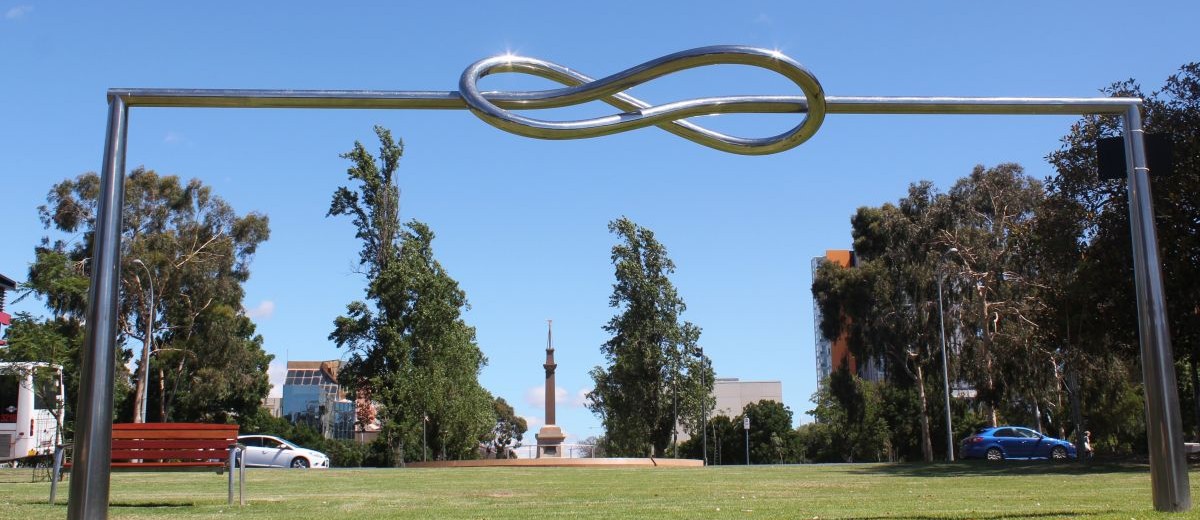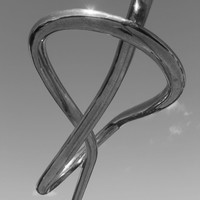Knot is one of several sculptures by Bert Flugelman that Adelaide residents and visitors enjoy. Flugelman is also the creator of Spheres in Rundle Mall and Tetrahedra and its smaller Vertical Variation at the Adelaide Festival Centre. All are straightforward, unadorned shapes of stainless steel, made striking by their monumental size and shining surface.
The Sculpture
It is tempting to run your hand along the twining, stainless steel tubing of Knot and peer into its polished surface - and that is just what its creator would have wanted:
When you put a public sculpture out into the world it reflects everything that is around it so it becomes an integral part of where it is… And because it is mainly geometric stuff, people don’t tend to ask what it’s meant to represent; they see it for what it is and they walk around it and they look at themselves and they pound on it and listen to it and accept it happily (cited in Cullen).
Knot was commissioned by the Adelaide City Council’s ‘Work in Public Places Fund’. It was loaned to the Art Gallery of South Australia where it was located from 1975 to 1995 before being removed due to redevelopment there. In 2003 it was relocated to the northern end of Light Square in Adelaide.
The artist
Herbert (Bert) Flugelman (1923-2013) was born in Vienna, Austria. He and his Jewish family fled Nazism for Australia in 1938. After working in factories, for a brief time in the bush and serving in the Australian Army (1943-46), Flugelman studied at the National Art School, Sydney (1948-51). He then travelled and worked overseas from 1951 to 1955. While overseas he contracted polio, which left him with some physical impairment. Undeterred, Flugelman continued his art practice, holding exhibitions at the Piccadilly Gallery in London and Bourne Gallery in New York. He also shifted his emphasis to sculpture.
Between 1972 and 1983 Flugelman lectured at the South Australian School of Art, eventually becoming the head of the sculpture component. During this period he produced several famous works, including Tetrahedra (1974), Spheres (1977) and Cones (1982) at the National Gallery of Australia, Canberra. In 1974, with several others, he established the South Australian Experimental Art Foundation.
Flugelman went on to become a senior lecturer at the University of Wollongong (1984-1991). In 1991 he was made a professorial fellow. In 1997 Flugelman received an Emeritus Award from the Australia Council's Visual Arts/Craft Fund. Numerous public works by Flugelman can be seen in Australian cities, including Wollongong, Sydney, Brisbane and Canberra.
The death of Bert Flugelman on 26 February 2013 at his rainforest home in Bowral, New South Wales was widely reported, with universal praise for him as an adventurous, warm, witty and generous man, and an inspiring teacher.
Australian, 7 March 2013, Deborah Hart, ‘Steel and geometry fed sculptor Bert Flugelman’s passion’, http://www.theaustralian.com.au/arts/visual-arts/steel-and-geometry-fed-...
City of Adelaide, ‘The Knot’, http://www.cityofadelaide.com.au/sights/the-knot
Cullen, Max, ‘Bert Flugelman: City Sculptor’, 16 June 2002, http://sgp1.paddington.ninemsn.com.au/Sunday/art_profiles/article_1067.a...
Design and Art Australia Online, ‘Bert Flugelman’, http://www.daao.org.au/bio/bert-flugelman/
Sydney Morning Herald, 28 February 2013, Donald Brook, ‘Master sculptor had passion for experimentation’, http://www.smh.com.au/national/obituaries/master-sculptor-had-passion-fo...
Wikipedia, ‘Bert Flugelman’, http://en.wikipedia.org/wiki/Bert_Flugelman




Add your comment